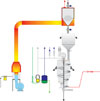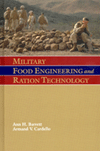
Rainer Perren, managing director, RPN Foodtechnology AG, Sursee, Switzerland
The newest option comes to California, source of 80 percent of global almond production, by way of Buhler Barth AG and the Institute of Food and Nutrition Science at the Swiss Federal Institute ETH in Zurich, Switzerland. Heading the institute’s project team is Rainer Perren. As a graduate student, Perren worked with a German fabricator of industrial roasting equipment to develop a two-step roasting process to create a semi-fluidizing system for nuts and oil seeds. The system now is operating commercially at more than a dozen nut processing facilities worldwide, roasting more than 100,000 tons a year. More recently, Perren has modified the technology to pasteurize and sterilize dry particulate foods without adversely affecting their flavor or visual appearance. The process is known as controlled condensation pasteurization and is being considered for California almonds.
A self-described food engineer, Perren focused on roasting technologies for hazelnuts in his doctoral dissertation at the Swiss Federal Institute of Food and Nutrition Science. Over the course of 12 years, he served as senior scientist for an industry-funded project investigating roasting technology for coffee beans, nuts and oil seeds. Perren formed RPN Foodtechnology AG in 2006, offering food manufacturers expertise in roasting techniques and pasteurization technology for particulate foods, control of water migration and water activity, and optimization of product quality, texture and shelf life.

A pasteurization system originally designed for cocoa is the foundation for a dry-particulate process for almonds, though moisture control is much more critical when maintaining product quality in tree nuts. Source: RPN Foodtechnology AG.
Perren: The cocoa industry realized long ago the need for sterilization against salmonella. Based on the technology available at Buhler Barth AG for cocoa, we developed and optimized a pasteurization system that involved a preheating step prior to pasteurization. Moisture increase is not a critical issue with cocoa because it must be treated thermally during further processing, when it becomes liquor. But retaining the original identity of the product is very important, just as it is with almonds. When we looked at the systems being applied to achieve a 5 log reduction of salmonella SE PT30 in almonds, we realized they lacked the ability to minimize an increase in the nut’s moisture content. We felt the preheating step in combination with establishing an equilibrium state prior to pasteurization could overcome this problem.
FE: The focus then was on modifying the cocoa system for almonds?
Perren: Cocoa is a fermented product exhibiting a complex microflora, but that is not the case with almonds. Therefore, this is not a case of technology being transferred to a new application. The equipment is nothing special; the vessel in which CCP is done is not important at all. What is important is the way we control the temperature and pressure, and we have applied for patents in the US and Europe for that aspect of the process.
FE: What are the steps in the process?
Perren: Dry heat is applied to preheat the almonds to a temperature below thermal equilibrium. Next, steam is introduced to establish thermal equilibrium at the desired pressure to achieve controlled condensation of water-film formation. Pasteurization has been demonstrated in the lab to more than a 5 log reduction in two minutes of Enterococcus faecium, a heat-resistant surrogate for salmonella enteritidis phage type 30. Finally, vacuum drying at 0.1 bar for five minutes is done to remove excessive surface moisture and to cool the almonds.
FE: Why are both dry heat and steam applied?
Perren: Survival of vegetative microorganisms is affected by temperature, the chemical composition of the substrate and pH. But with particulate foods, the key variable in inactivation kinetics is water activity. It takes 4-10 times longer to pasteurize a particulate food at 0.8 Aw than a particulate at 0.99 Aw. Almonds typically are 0.6 Aw, with 5%-6% moisture content. Dry heat is not suitable for surface pasteurization; it increases the internal temperature and drives out water, but the surface evaporation that occurs reduces the temperature, and no steady-state temperature is achieved. As a result, the process takes longer, and moisture loss causes product modification or even deterioration. For example, a 2 log reduction in rawhide with water activity of 0.9 Aw is achieved in 1-2 hours, but it takes 30 hours to achieve a 5 log reduction.
FE: Aren’t the effects of evaporative cooling and moisture pickup factored into existing almond-pasteurization processes?
Perren: The kinetics of equilibrium is well understood and very obvious to physicists, but many people who devise food processes never make this link. This is primarily a matter of thinking about what is going on, what we are trying to achieve, and how we achieve it. The best inventions are those that make that link.
If the temperature difference between the pasteurization set point and the almond is sufficiently great, more moisture will condense on the surface during the process and be taken up by the nut. To avoid that uptake, preheating to create a state of equilibrium is absolutely critical. The proper temperature is product dependent and varies based on the volume, weight and surface area of the product.
FE: How much vacuum do you pull during pasteurization?
Perren: It corresponds to the surface-pasteurization temperature and the particulate being treated. For almonds, it is about half an atmosphere. Existing industrial systems operate under atmospheric conditions. That dramatically increases the amount of moisture uptake, which leads to product degradation.
The operating system pressure determines the temperature at which the bacteria are killed. A vacuum allows you to lower the temperature needed to destroy a microbe’s ability to multiply, although it takes longer. At 0.7 bar, a temperature of 90



